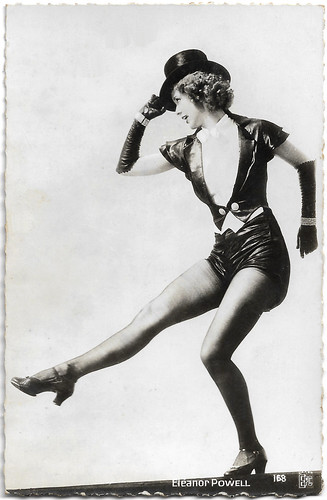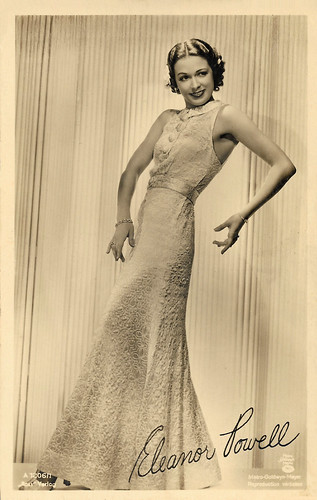
British postcard by Valentine's, no. 7187. Photo: Metro-Goldwyn-Mayer. Eleanor Powell in Broadway Melody of 1936 (Roy Del Ruth, 1935). Caption: Eleanor Powell who is described as the 'World's Greatest Feminine Tap Dancer' is here seen doing 'The Broadway Rhythm' in Broadway Melody of 1936, Metro-Goldwyn-Mayer's latest film.

Big German card by Ross Verlag. Photo: Ted Allan / Metro-Goldwyn-Mayer. Eleanor Powell in Born to Dance (Roy Del Ruth, 1936).

British Art Photo postcard, no. 45. Photo: Metro-Goldwyn-Mayer.

German postcard by Ross Verlag, no. A 2294/1, 1939-1940. Photo: Metro-Goldwyn-Mayer. Sent by mail in 1939.

British Art Photo postcard, no. 45. Photo: Metro-Goldwyn-Mayer. Eleanor Powell in Lady Be Good (Norman Z. McLeod, Busby Berkeley, 1941).
Playing the floor as if it were an instrument
Eleanor Torrey Powell was born in Springfield, Massachusetts in 1912. Her parents were Clarence Gardner Powell and Blanche Torrey Powell. Her father left her and her mother when she was two years old. She was raised by her mother with the help of her maternal grandparents who lived with them. Eleanor was a painfully shy child, not even able to greet guests who would come into her family’s own house. She learnt ballet to combat her shyness.
At the age of eleven, she was discovered by Gus Edwards, the owner of the 'Vaudeville Kiddie Review'. She subsequently began working her first paid gigs for Edwards, during her summer holidays. In 1928, Powell began a package of ten tap lessons at a school run by Jack Donahue and Johnny Boyle. These lessons would be the only formal tap training she would ever have. In training Powell, Donohue and Boyle used an unconventional method.
Wikipedia: "To counteract her tendency toward pulling away from the floor and working through her feet, as one does in classical ballet and acrobatics, they had her wear an army surplus belt during her lessons, which had one sandbag attached on either side. This was intended to weigh her down, help her to feel the floor differently, and engage with it – to 'play' the floor as if it were an instrument. This not only served to help Powell 'find her legs' in tap dance, it also was to be a catalyst in the development of her uniquely grounded and smooth tap style."
When she was seventeen, Powell made the move to Broadway where she made her debut in the revue 'The Optimists'. She starred in several musicals on Broadway and quickly became a renowned performer, nicknamed 'The world's greatest tap dancer'. In 1930, Eleanor Powell's first film in Hollywood, Queen High (Fred C. Newmeyer, 1930) was unsuccessful. On Broadway, she had more success in the musicals 'Fine and Dandy' (1930) and 'At Home Abroad' (1935).
She returned to Hollywood to perform a 'specialty dance' in the Fox musical George White's 1935 Scandals (George White, 1935). It was a major film debut for the young dancer. According to Powell's introduction to the book 'Gotta Sing, Gotta Dance', a mix-up in the make-up department resulted in her being made to look almost Egyptian. She left the production so disenchanted with film-making, that she initially rejected a contract offer by MGM.

French postcard by Editions et Publications cinématographiques (EPC), no. 168.

German postcard by Ross Verlag, no. A 1206/1, 1937-1938. Photo: Metro-Goldwyn-Mayer.

German postcard by Ross Verlag, no. A 1974/1, 1937-1938. Photo: Metro-Goldwyn-Mayer.

British postcard in the Picturegoer Series, London, no. 1036a. Photo: Metro-Goldwyn-Mayer.

German postcard by Ross Verlag, no. A 2177/1, 1939-1940. Photo: Metro-Goldwyn-Mayer.
One of the best tap dance scenes in the history of film
Later in the year, MGM placed Eleanor Powell in the popular musical Broadway Melody of 1936 (Roy Del Ruth, 1935) with Jack Benny. The film was nominated for the Academy Award for Best Picture. According to dancer Ann Miller, quoted in the 'making-of' documentary That's Entertainment! III, MGM was headed for bankruptcy at the time, but the films of Eleanor Powell, particularly Broadway Melody of 1936, were so popular that they made the company profitable again.
Powell's lavish musicals including Born to Dance (Roy Del Ruth, 1936) with James Stewart, Rosalie (W.S. Van Dyke, 1937) with Nelson Eddy, Broadway Melody of 1938 (Roy Del Ruth, 1937) with Robert Taylor and Honolulu (Edward Buzzell, 1939) proved extremely lucrative. Powell tap-danced in almost all her films. Her singing scenes, on the other hand, were always dubbed.
The highlight of her career came in 1940 when she featured alongside Fred Astaire in Broadway Melody of 1940 (Norman Taurog, 1940). Their scene 'Begin the Beguine' with music by Cole Porter is recognised by several critics as one of the best tap dance scenes in the history of film. Film historians wrote that Powell was the only dancer by whom Astaire was dwarfed. Shortly after the premiere of this film, Powell had to undergo an ulcer operation.
After this, her popularity went downhill. She got smaller and smaller roles in films and missed out on more and more film roles, including the leading role in For Me and My Gal (Busby Berkeley, 1942). After a cameo in Thousands Cheer (George Sidney, 1943), she left MGM. Later that year, she married Glenn Ford. When she had a son, Peter Ford, she decided to retire. She made a one-off trip to the studio, for a cameo in Duchess of Idaho (Robert Z. Leonard, 1950), starring Esther Williams and Van Johnson. Powell later made another career in the television industry and she joined the Unity Church. Shortly after her divorce from Ford in 1959, she opened her nightclub, which received a lot of publicity.
In 1974, Powell was reintroduced to audiences in the popular compilation film That's Entertainment! (Jack Haley Jr., 1974) and its sequels That's Entertainment Part II (Jack Haley Jr., 1976) and That's Entertainment! III (Bud Friedgen, Michael J. Sheridan, 1994) and the related film That's Dancing! (Jack Haley Jr., 1985) which spotlights her dancing in films such as Broadway Melody of 1940 (Norman Taurog, 1940), Lady Be Good (Norman Z. McLeod, 1941), and Born to Dance (Roy Del Ruth, 1936). Powell made her last public appearance in 1981 when she attended a televised American Film Institute tribute to Fred Astaire. Upon her entry, she received a standing ovation. A year later, in 1982, Eleanor Powell died of ovarian cancer in Beverly Hills, California, at the age of 69. She is buried at Hollywood Forever Cemetery in Los Angeles.

British postcard in the Film Partner Series, London, no. P. 186. Photo: Metro-Goldwyn-Mayer. Robert Taylor and Eleanor Powell in Broadway Melody of 1938 (Roy Del Ruth, 1937).

Italian postcard by Rizzoli & C. Milano, 1938. Photo: Metro-Goldwyn-Mayer.

French postcard by Collection Chantal, Paris, no. 419. Photo: Metro-Goldwyn-Mayer.

French postcard by A.N., Paris, no. 1157. Photo: Metro-Goldwyn-Mayer.

Vintage postcard.
Sources: Wikipedia (Dutch, French and English) and IMDb.
No comments:
Post a Comment